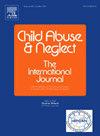巴基斯坦年轻人不良童年经历(ace)的患病率及其与当前心理健康的关系
IF 3.4
2区 心理学
Q1 FAMILY STUDIES
引用次数: 0
摘要
童年不良经历(ace)是重要的压力源,会对个人健康,尤其是心理健康产生持久影响。尽管在乌干达和印度等低收入和中等收入国家(LMICs),高达91%的人受到急性呼吸道感染,但在巴基斯坦的研究仍然很少且不发达,这限制了跨国比较。目的了解巴基斯坦18至25岁年轻人的ace患病率及其对当前心理健康的影响。参与者和背景18-25岁的学生在巴基斯坦拉瓦尔品第选定的公立和私立大学就读13 - 16年级。方法采用方便抽样法。ACE暴露评估使用ACE国际问卷的修改版本。使用沃里克-爱丁堡短心理健康量表评估心理健康。描述性统计用于描述参与者的社会人口统计特征,包括年龄、性别、机构类型(公立与私立)、父母婚姻状况、父母教育程度、家庭月收入和兄弟姐妹数量。采用多变量logistic回归来确定ace与学生心理健康之间的关系。结果454名参与者中,男性203名,女性251名;平均年龄(22.1±2.2岁),98%的患者一生中至少经历过一次ACE, 82.4%的患者经历过三次或以上ACE。最常见的ace是目睹社区暴力(88%)、同伴暴力(83%)和家庭暴力(73%)。精神虐待(60%)比身体虐待(47%)和性虐待(37%)更为普遍。与得分为0-2分的学生相比,得分为6分及以上的学生心理健康状况不佳的几率高出3.39倍(AOR = 3.39;可信区间1.44 - -8.0;p & lt;0.01)。该研究揭示了巴基斯坦学生中ACE的患病率,高ACE暴露与较差的心理健康相关。解决急性呼吸道感染问题需要更广泛的公共卫生方法,敦促采取政策干预措施,以减轻对健康的长期影响。本文章由计算机程序翻译,如有差异,请以英文原文为准。
Prevalence of Adverse Childhood Experiences (ACEs) and its association with current mental wellbeing among young adults in Pakistan
Background
Adverse Childhood Experiences (ACEs) are significant stressors that can have lasting effects on an individual's health, especially on mental wellbeing. While ACEs affect up to 91 % of individuals in low- and middle-income countries (LMICs) such as Uganda and India, research in Pakistan remains sparse and underdeveloped, limiting cross-country comparisons.
Objective
To determine the prevalence of ACEs among young adults aged 18 to 25 in Pakistan and their impact on current mental wellbeing.
Participants and setting
Students aged 18–25 years enrolled in grade 13th–16th of selected public and private colleges of Rawalpindi, Pakistan.
Methods
Participants were recruited through convenience sampling. ACE exposure was assessed using a modified version of the ACE-International Questionnaire. Mental wellbeing was evaluated using the Short Warwick-Edinburgh Mental Wellbeing Scale. Descriptive statistics were used to characterize participants' socio-demographics including age, gender, type of institution (public vs. private), parents' marital status, parental education, monthly household income, and number of siblings. Multivariable logistic regression was conducted to determine association between ACEs and the mental wellbeing of the students.
Results
Among 454 participants (203 males, 251 females; mean age 22.1 ± 2.2 years), 98 % experienced at least one ACE during their lifetime, with 82.4 % experiencing three or more ACEs. The most common ACEs were witnessing community (88 %), peer (83 %), and household (73 %) violence. Emotional abuse (60 %) was more prevalent than physical (47 %) and sexual (37 %) abuse. Students experiencing 6 or more ACEs had 3.39 times higher odds of inadequate mental wellbeing compared to those with 0–2 ACEs (AOR = 3.39; CI 1.44–8.0; p < 0.01).
Conclusions
The study reveals a concerning ACEs prevalence among Pakistani students, with higher ACE exposure correlating with poorer mental wellbeing. Addressing ACEs requires a broader public health approach, urging policy interventions to mitigate long-term health impacts.
求助全文
通过发布文献求助,成功后即可免费获取论文全文。
去求助
来源期刊

Child Abuse & Neglect
Multiple-
CiteScore
7.40
自引率
10.40%
发文量
397
期刊介绍:
Official Publication of the International Society for Prevention of Child Abuse and Neglect. Child Abuse & Neglect The International Journal, provides an international, multidisciplinary forum on all aspects of child abuse and neglect, with special emphasis on prevention and treatment; the scope extends further to all those aspects of life which either favor or hinder child development. While contributions will primarily be from the fields of psychology, psychiatry, social work, medicine, nursing, law enforcement, legislature, education, and anthropology, the Journal encourages the concerned lay individual and child-oriented advocate organizations to contribute.
 求助内容:
求助内容: 应助结果提醒方式:
应助结果提醒方式:


